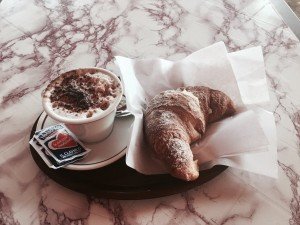My Welcome to Sicily
While sleeping off a bit of jet leg from what seemed like a three-day plane ride, my cousins were busy preparing a simple lunch for us. I awoke to a room full of relatives sitting at the table, with my cousin, Vitanna, serving a five-course seafood lunch.
Our first course included a mixture of olive oil, garlic, tomatoes, tuna and fresh parsley simmered, and served on top of pasta. Don’t be surprised by the absence of spices. Spices had indeed been the characteristic sign of rich cooking over a thousand years.
However, by the sixteenth century they began to lose favor at exactly the moment when their abundance made their use possible on a global scale. Exploration and conquest enabled travelers to obtain spices directly from the site of their production. But the overabundance of aromas and flavors that flooded Europe at that time soon generated a sense of fatigue. Now that fine spices were within the reach of many, if not all, the “truly rich” looked elsewhere for signs of distinction. According to I Tempi Moderni, Flandrin, “the royal court of France extended throughout northern regions of Italy. Though not ruled by France, the nobles and the locals of those regions, interested in “the new” for their dining pleasure, rediscovered indigenous flavors. Thus, chives, scallions, mushrooms, capers, and anchovies began to replace spices.”
Next up was a seafood salad; a mixture of octopus (polipo), squid (totano), cuttlefish (seppie), mussels (cozze) clams (vongole), and shrimp (gambero), all boiled together and served with olive oil and salt and pepper. Now you know you are in Sicily after a dish like this. Secondo, the second course, was a beautiful fish rolling, stuffed with breadcrumbs, pine nuts, raisins and oil, then rolled in breadcrumbs and baked for 20 minutes at 400 degrees. Another course, the contorno, of green beans and grilled eggplant complemented our delicious fish.
The eggplant is a perfect example of the diversity of Sicily over thousands of years of multi-cultural occupations. The Middle Eastern Arabs brought eggplants, as well as rice and even pasta, to Sicily. It is a very romantic myth that Marco Polo brought pasta from China to Venice. The migration of pasta came from Persia, working its way east to China and west to Spain and Sicily. The Arabs invented the process of drying pasta for later use, which was brought to Europe, and their invention ignited the pasta production industry in Sicily.
We neared the end of our lunch with macaroons and fruit for dessert. As I took my knife to remove the core of the pear, that was freshly picked from my cousin’s garden, the pear juice began to run down the side of my hand. I could almost taste the sweetness of the pear juice through the skin on my hand, a perfect ending to a beautiful Sicilian lunch.
After our good-byes, my cousin, Luciana, handed me the keys to her car. I got the chance, once again, to enjoy the thrill and excitement of driving down the mountain for a ride to Palermo to Luciana’s home. Now, they say if you can drive in Palermo, you can drive anywhere. Between the constant shifting of gears and the dodging of the motorbikes weaving past and around me like bees, I paid constant attention, as Luciana barked out directions. This was further complicated with the giant vision of large-breasted women adorning large billboards advertising who knows what. As if one needs anymore distractions while trying to survive a kind of “Mr. Toad’s Wild Ride.”
The next morning, I took a simpler mode of transportation: my feet. Although, a walk all the way down to the Port of Palermo at times, could be as dangerous. This 10-mile trek should be taken at early dawn, since by 7 AM, the heat would already reach 90 degrees. Fortunately, the historic buildings provided plenty of shade along my path.
Now, Palermo is a city that could use a good power washing from one end to another, removing the grit of 1000 years from some of its buildings. Maybe this grit and the crumbing of some of its buildings could only be appreciated by a kid who grew up near Detroit. But I love it just the same. Just like its food, the building and architecture reflect the diversity of its conquerors. A stop for a pastry and a cup of cappuccino and my welcoming to Sicily is complete. I am home!
Blog Posts













